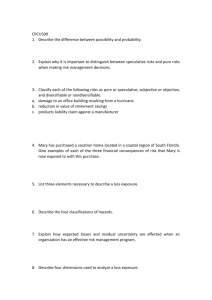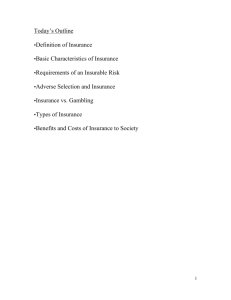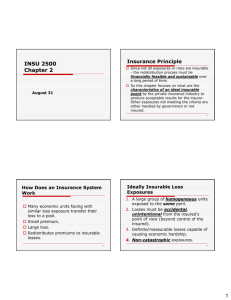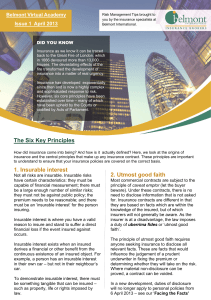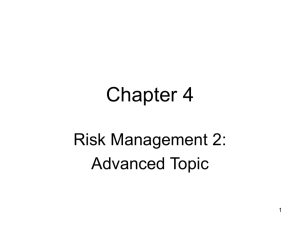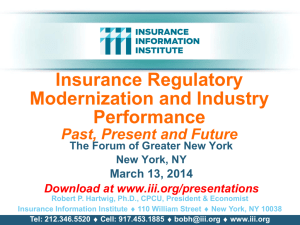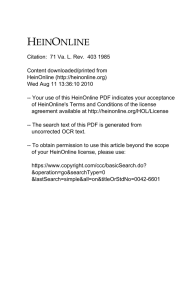Insurance Principles - The Griffith Foundation
advertisement
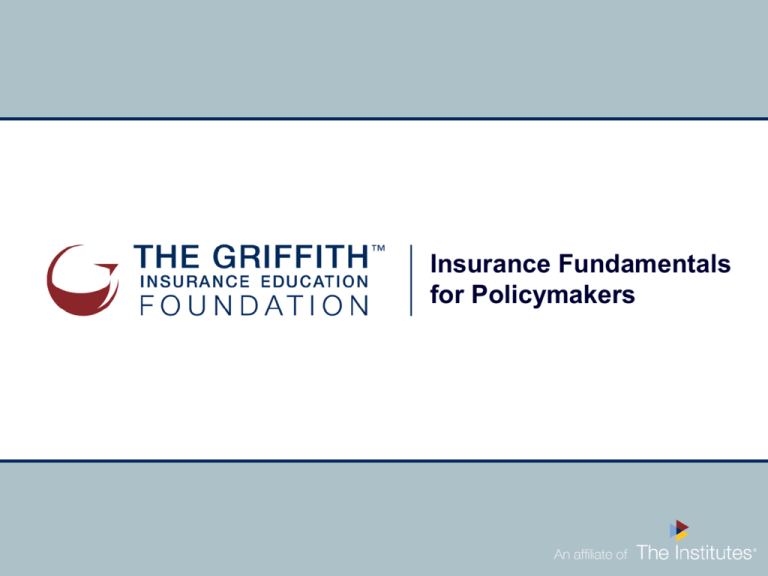
Insurance Fundamentals for Policymakers Insurance Fundamentals for Policymakers Four assignments: • Insurance Principles • Insurance Coverages: Property and Casualty • Insurance Coverages: Life and Health • Insurance Regulation and Legislation Insurance Principles Topics • • • • • Insurance Basics Economic Issues Related to Insurance Pricing Characteristics of the Insurance Product Insurance as a Risk Management Technique Why Insurance Operations Are Regulated Insurance Basics Insurance provides financial security, and it does so based on principles that ensure that all covered losses will be indemnified. Foundational Insurance Terms • Risk • Perils • Hazards Foundational Insurance Terms • Losses • Loss frequency • Loss severity What Is Insurance? • A means of treating risk by transferring the financial consequences of a loss to an insurance company • A means of protecting financial interests when losses occur How Insurance Benefits Insureds • • • • Pays insured’s covered losses (indemnifies) Reduces uncertainty Encourages efficient use of resources Helps reduce and prevent losses How Insurance Benefits Business and Society • • • • • Supports credit Satisfies legal requirements Satisfies business requirements Provides sources of investment funds Reduces social burdens Costs of Insurance to Insureds • Premiums • Opportunity costs Costs Associated With Insurance • • • • Operating costs – including profit Fraudulent and inflated claims (moral hazards) Claims caused by carelessness or indifference (morale hazards) Frivolous lawsuits that are settled as nuisance claims Fundamental Insurance Principles These principles help ensure that the insurance mechanism is actuarially sound: – Indemnification – Law of large numbers – Insurable interest The Principle of Indemnity • Insurance should not benefit an insured beyond the value of a loss. • Violations of this principle can increase the frequency and severity of losses. The Law of Large Numbers • The mathematical basis of insurance. • Insurance coverage provided is large relative to the premium paid. • What would be an unexpected loss for an individual becomes an expected loss in aggregate for an insurer. Insurable Interest • Means that the insured must suffer financially should a loss occur • Supports the principle of indemnity—one cannot gain from an insurable loss Economic Issues Related to Insurance Pricing An insurance policy is priced to reflect the loss exposures the policy covers while allowing for expenses, profit, and contingencies. Key Issues in Pricing • • • • Adverse selection Moral and morale hazard Equity: actuarial and social Timing Adverse Selection Adverse selection increases insurers’ costs. – Those with the greatest probability of loss are most likely to buy insurance. – They tend to have more losses and higher claims than insureds with an average loss probability. Avoiding Adverse Selection: Data Collection • Insurers need information about insureds to set prices that reflect risks. • Data collection raises privacy concerns: – What information is relevant? – How much information is too much? Moral and Morale Hazard • Behaviors that increase loss frequency and/or severity – Moral—dishonesty – Morale—carelessness or indifference • Common in auto, products liability, and general liability insurance • Can be discouraged with policy risk-sharing features (deductibles) Actuarial Equity Versus Social Equity • Fair discrimination—equitable premium for each insured—is essential to insurance pricing. • State insurance laws prohibit unfair discrimination in insurance pricing. • Opinions vary about what is fair and unfair. Actuarial Equity • Premium is directly proportional to each insured’s loss exposures. • Cost-based pricing—identifies every variable unique to each insured. • Use of some variables may be prohibited by state law. Social Equity Social equity involves two concepts: • Pricing should relate to ability to pay. • Factors beyond an insured’s control should not affect premium. Timing • Most losses are recognized, valued, and settled quickly (short-tail losses). • Some losses take a long time to manifest, value, and settle (long-tail losses). • The longer the tail, the greater the uncertainty in expected losses. What Is an Ideally Insurable Risk? • An ideally insurable risk has six characteristics. • Insurers use these characteristics to decide which risks to insure. • Insurers select only those risks that meet most of the criteria. Characteristics of Insurable Risks • A large quantity of similar people or objects may be subject to a loss. • Loss would be fortuitous. • Loss would not be catastrophic to the insurer. Characteristics of Insurable Risks • Time, location, and extent of a loss can be determined. • The amount of an expected loss can be predicted. • Covering the expected loss is economically feasible for the insurer. Characteristics of the Insurance Product Insurance products share several characteristics that distinguish them from other types of consumer products. Intangibility The insurance product – Lacks physical characteristics – Is more than the policy on paper – Represents a promise (to pay in the event of loss) Complexity and Legal Status • An insurance policy contains complicated terms and concepts. • An insurance policy is a legal contract. – Insureds and claimants may hire attorneys to resolve or clarify issues. – Some issues may involve courts, regulators, or legislators. Insurance Circumstances Product benefits become most apparent at time of loss. – Insureds or claimants may be facing unpleasant circumstances. – Heightened emotions may complicate transactions. Insurance as a Risk Management Technique Loss exposures with serious financial consequences typically require the purchase of insurance. Risk Management Techniques • Retention • Avoidance • Control – Prevention – Reduction • Transfer (including insurance) Retaining Loss Exposures • Some loss exposures have the potential to cause financial ruin. • Others present minimal potential costs and can be safety retained. Avoiding Loss Exposures • Ceasing or never undertaking an activity eliminates potential loss from that activity. • Example: Not owning or driving an auto eliminates potential auto liability losses. Controlling Loss Exposures • Loss prevention measures reduce the frequency of injuries. • Loss reduction measures reduce the severity of fire losses. Transferring Risk • Some loss exposures are most effectively managed by transfer. • The financial consequences of loss are borne by another party. • Insurance is a common risk transfer technique. Why Insurance Operations Are Regulated The fundamental purpose of insurance regulation is to protect the public as consumers and policyholders Reasons for Regulation • To protect consumers • To maintain insurer solvency • To prevent destructive competition Consumer Protection – Regulating and standardizing insurance policies and products – Controlling market conduct and preventing unfair trade practices – Ensuring that insurance is available and affordable Insurer Solvency Regulation • Ensure an insurer’s claim-paying ability • Protect the public interest • Safeguard insurer-held funds Prevention of Destructive Competition To ensure the availability of insurance by controlling rates – – – – Insurers, to compete, may lower rates. Intense competition can drive down rate levels across the market. Some insurers may become insolvent. An insurance shortage may result. Summary Insurance is • A risk management technique that involves transfer of risk to an insurance company • A complex legal contract • Affected by adverse selection, moral and morale hazard, actuarial and social equity, and timing • Regulated to protect consumers and policyholders
